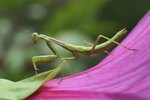
The praying mantis is a predatory insect that feeds on moths, flies, crickets, grasshoppers and even members of his own species. Even though the praying mantis is an expert at camouflaging into the flora and fauna of the environment he lives in, praying mantis is easily identified if you know what you're looking for.
The Head
The praying mantis has a triangular head that is located at the end of his very long neck. The head of the praying mantis features two large, compound eyes and three smaller, normal eyes. The compound eyes allow the mantis to see through a collection of visual receptors and provide him with a more complete view of possible prey around it. The mantis can also swivel his head 180 degrees to further improve its ability to locate and capture prey.
The Body
The praying mantis hunts successfully by blending into his environment. At first glance, the mantis has the appearance of a twig and small leaf. The praying mantis is typically brown or green in color and shaped similarly to a leaf with six legs. The mantis captures his prey by either laying in wait for it and ambushing it or by stalking the prey until capture.
The Legs
The two front legs of the praying mantis are held close together in an upright position, giving it the appearance that it is praying -- hence the name. Those same legs are also used to physically grab the prey that they eat; the mantis has very quick reflexes in his front legs. Once the mantis has caught the prey, the spikes on his legs help keep the prey pinned in place as he consumes it.
The Juvenile Praying Mantis
Praying mantis females lay eggs which then hatch into juvenile nymphs. The nymphs have the same general appearance as the adults. Both adults and nymphs are known to cannibalize one another if there isn't another source of food readily available. It's not unusual for a female praying mantis to consume her mate during or after copulation.
References
Photo Credits
-
Zedcor Wholly Owned/PhotoObjects.net/Getty Images
Writer Bio
Jen Davis has been writing since 2004. She has served as a newspaper reporter and her freelance articles have appeared in magazines such as "Horses Incorporated," "The Paisley Pony" and "Alabama Living." Davis earned her Bachelor of Arts in communication with a concentration in journalism from Berry College in Rome, Ga.




